The Lockdown Projects - Page 2
On this page there will be displays of work created by Members whilst on lockdown. These are the 'Lockdown Projects'. This is the equivalent of the 'display table' from Club nights. This is Page 2 of the projects - click HERE to display Page 1 or HERE to display Page 3 and HERE to display Page 4 or HERE to display Page 5
or HERE to display Page 6
Here is some of the Members' work created in lockdown…
|
Arthur Kingdon has been busy in his workshop - being creative in making boxes on various ornamental lathes. Each box takes around 10 to 15 hours to complete. On top of that is the time spent in selecting suitable timber, designing the box, and working out how to hold and actually make it by determining the processes required and the order of applying them.
Arthur says they do take a long time but I'm trying to standardise on some sizes so I can make jam chucks that will survive several uses. I use 4 different lathes when I do the spiral work - a Nova DVR for roughing out/ coring, an Evans ornamental turning lathe, circa 1880 for the spirals, a Holtzapffel ornamental turning lathe circa 1811 for fitting the parts together and for any work with an eccentric cutting frame, and finally a rose engine (a modified Holtzapffel) for the decoration on lids and bases. All machines have different nose threads, so that means time spent with a dial test indicator to get pieces running true when transferring between machines. |
|
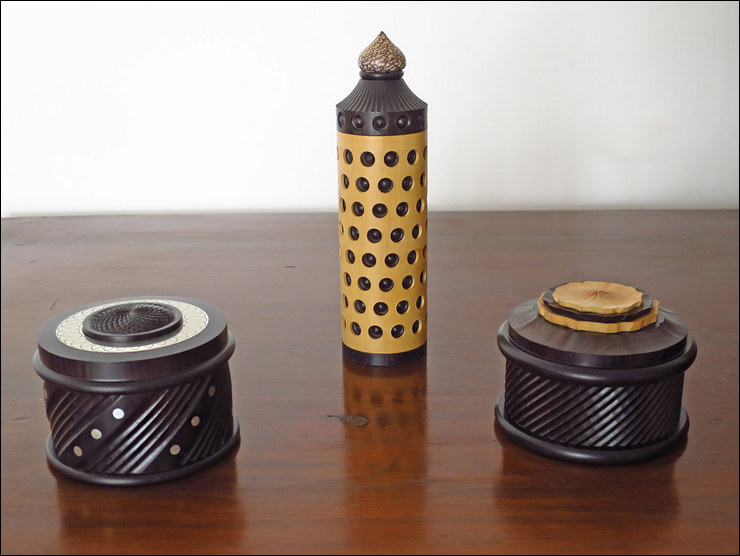 |
|
| This box is African Blackwood with solder wire and a pewter insert in the lid. The height 45mm, diameter 65mm. The top has 32 circles cut into the pewter with an eccentric cutting frame then filled with Araldite coloured with black poster paint - sadly, not perfect but too much time had been invested in the piece to bin it. Spiral fluted sides with plain areas drilled and filled with solder wire. The interior and base decoration was done on a rose engine. |
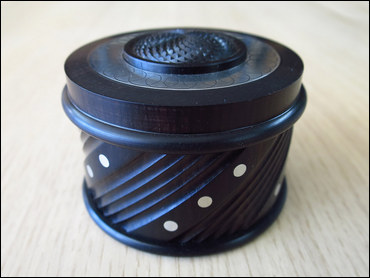 |
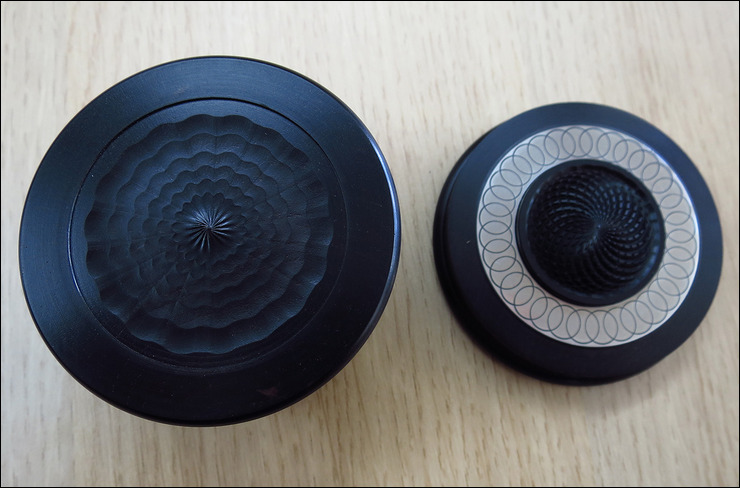 |
|
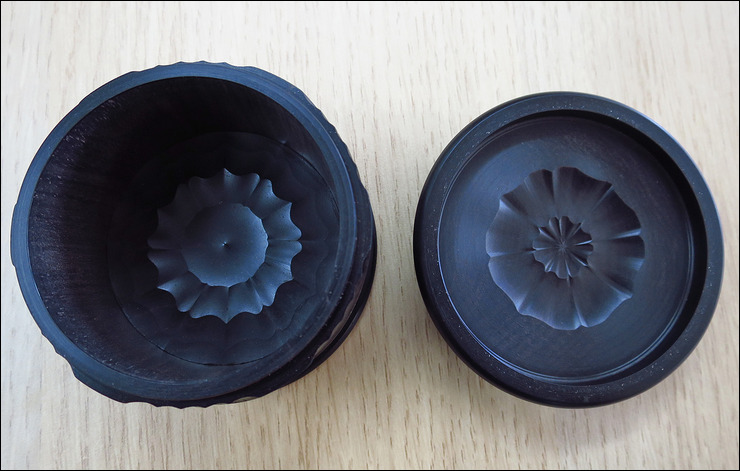 |
|
This box is African Blackwood with boxwood on the lid. The height 50mm, diameter 70mm. Spiral fluted sides with rose engine cut 3 layer 'flower' on top. Rose engine decoration inside lid and on base. |
|
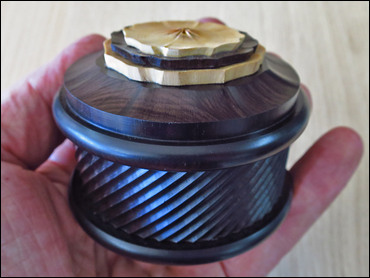 |
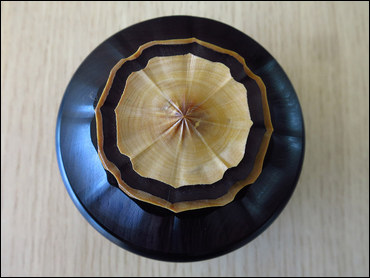 |
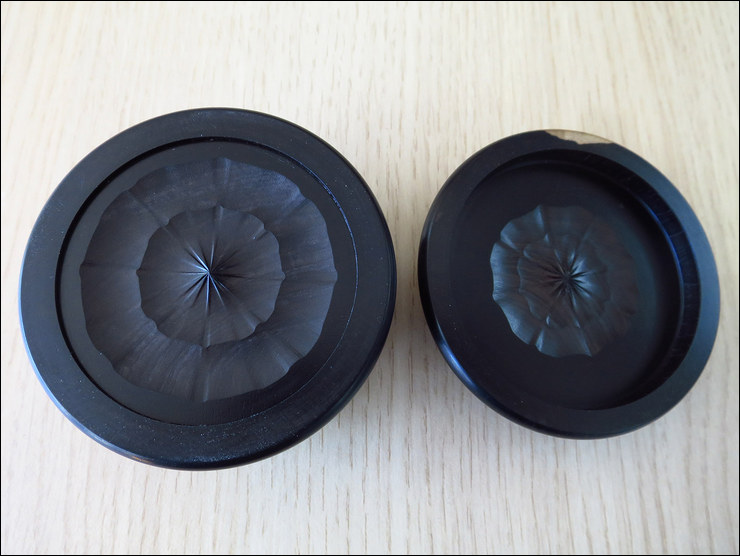 |
|
This box was an experiment, using different (for me) techniques and materials. It comprises a cylinder of African Blackwood inside a cylinder of boxwood. Done by using a lathe equipped with a sliderest for accuracy - this could be done freehand by better turners than me. It was then an exercise in using a pearling drill (a concave semicircle) while indexing to achieve a slight spiral effect. The top has a finial made of betel nut. I'd never used this before but I'd seen a few examples by an American turner and I was keen to try it. Purchased on eBay - £3.99 for ten. It's not particularly hard and It turns easily with a spindle gouge, but does not like a scraper. I do like the variegated markings and will certainly use this material again. The first couple I tried seemed to have lots of voids and ended up in the bin. The next two seemed solid and turned without any problems. The tall, slim design is inspired by a box I saw on the Internet but may be a bit Marmite to some. The height is 135mm and the diameter is 35mm. |
|
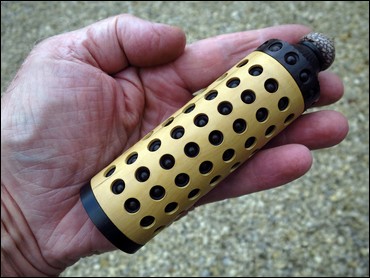 |
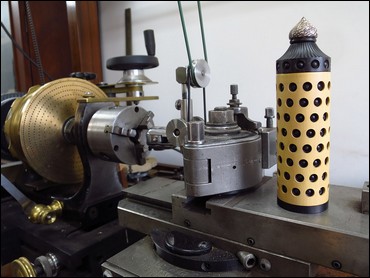 |
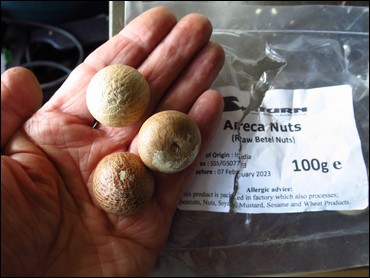 |
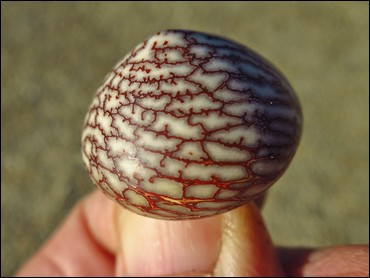 |
 |
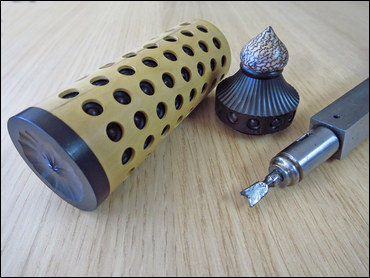 |
Examples of 'pearling' or 'beading' drills. The drills were originally sold in sets of graduated sizes and shapes. |
|
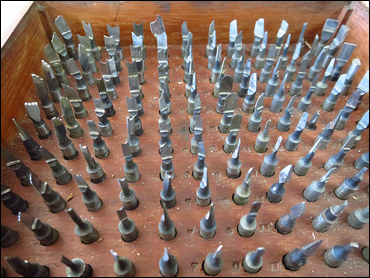 |
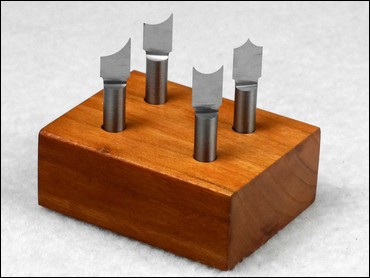 |
| Hank van de Weg needed a birthday present for his son's birthday. His son has a pizza facility on his BBQ - so, Hank made this ideal gift of a pizza platter and cutter. The timber used was upcycled from the top of an old fold up table, about 20mm thick with a diameter of 360mm. This was a hard wood similar to Ash (but not sure). No flexing of the material on turning. All the existing finish was removed, to be followed by sanding up to 500 grit and then finished with Tung Oil. The cutter handle was also in Ash, sanded up to 500grit, Chesnut Cellulose Sealer then finished with Hampshire High Sheen Wax. It was interesting to use the 90 degree swivel on the lathe and the banjo extension for the first time. |
|
 |
 |
| Kevin Taylor has been engaged in a number of different projects - starting with an off-centre bowl in sycamore. This was held on a waste block, hot melt glued to the base, an Axminster Eccentric chuck was used to offset the blank. The bowl was then held in Cole Jaws to clean up the base then, sanded through the grits to 600 and finished in wood wax 22 clear finish. The bowl is approx. 8" diameter by 1" tall.
|
|
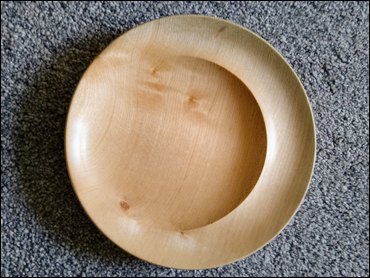 |
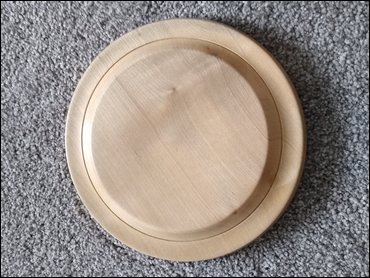 |
|
This "basket weave" bowl is a work in progress - multiple beads turned on the outside and highlight/ burned with a steel wire, the lathe indexer was used to mark out the cross-lines - which were burned with a pyrography pen. |
||
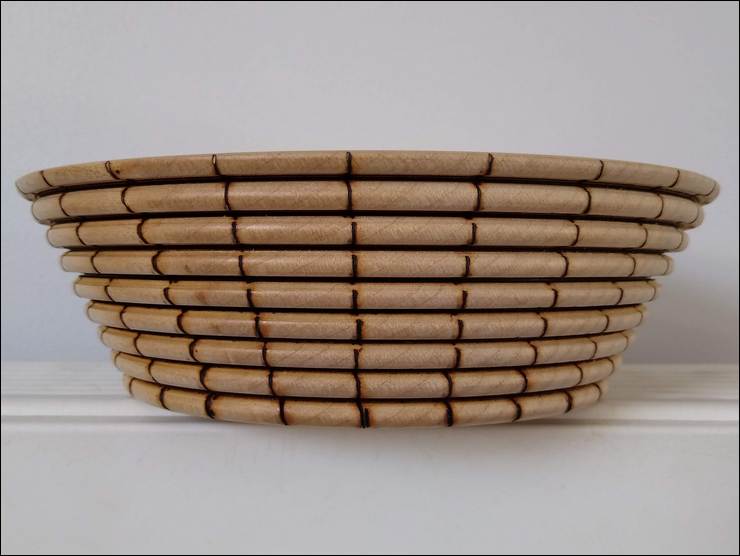 |
||
A segmented turned pot - made from various timbers that had been kept for a 'rainy day'... |
||
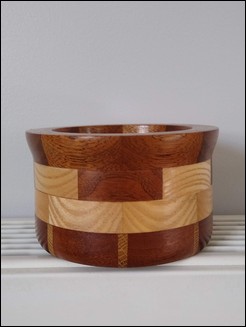 |
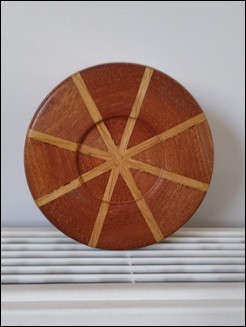 |
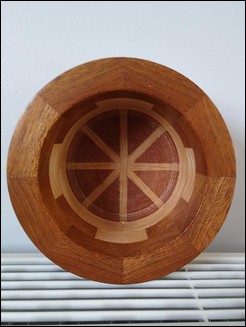 |
A Christmas Tealight - made in ash - with a series of drilled holes (in the shape of a tree) - complete with a battery driven 'candle' set into the base. |
||
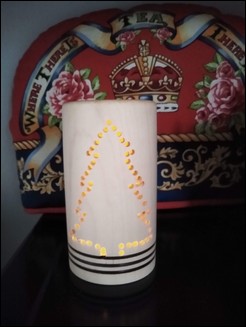 |
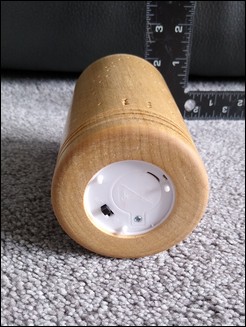 |
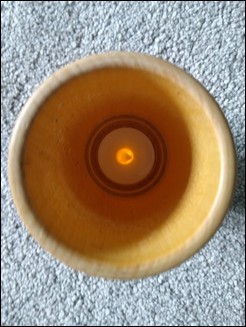 |
| A snowman - made initially as skew chisel practice - then decorated with a burning wire (on the hat) and with a pyrography pen. The snowman is approx. 3 1/2" tall by 1 1/2" diameter. |
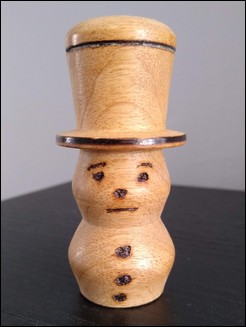 |
|
| Roger Blake has been busy in his workshop making bowls and experimenting with colours and wood stains. The bowl on the left is in pine - 4.5" diameter, with purple and orange spirit staiined rim - on the right is an ash bowl - 6" diameter, with black spirit stain and silver cream highlights rubbed into the grain. |
|
 |
 |
On the left is a 6" diameter bowl in ash with an oak insert in the base. Blue spirit stained rim with silver cream highlights. On the right is an 8" diameter oak bowl. |
|
 |
 |
Nine inch diameter ash discus bowl with ebonised rim, highlighted with gold gilt cream |
|
 |
 |
| Sewing Needle Cases - with push fit lids. 3 in oak and 2 in walnut |
 |
| Steve Body has recently been pursuing an Olivewood binge. Olivewood is a relatively expensive timber, which rapidly escalates as the section size increases. Steve has found that the website "Olive Wood Turning" (see here: www.olivewoodturning.co.uk) are very helpful and reasonably priced. Quote: "These pieces are my first foray into turning hollow forms and I have to say, it's become quite addictive. The thought of turning in the dark - not being able to see the tool point - has been nowhere near as scary as I thought it might." The 3 - hollow form vases complete with African blackwood tops are approx. 4" to 5" tall. The vase is 6" tall. All of the items are finished with Finishing Oil and then, when dry, lightly buffed (on a Beall loose cotton wheel) – nothing else added. |
|
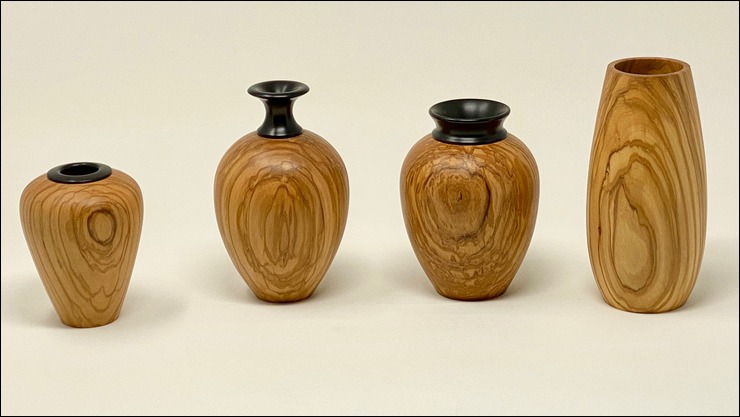 |
|
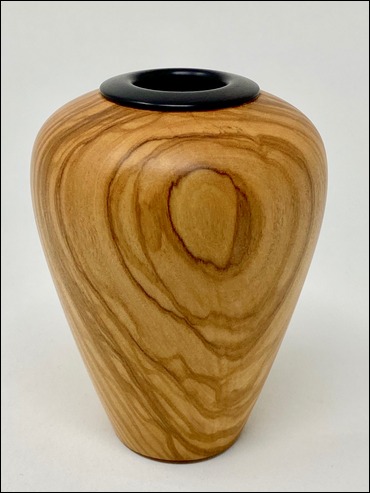 |
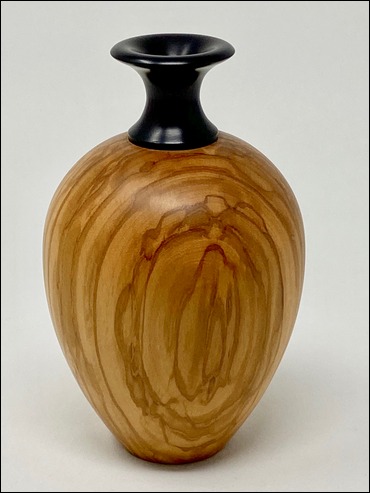 |
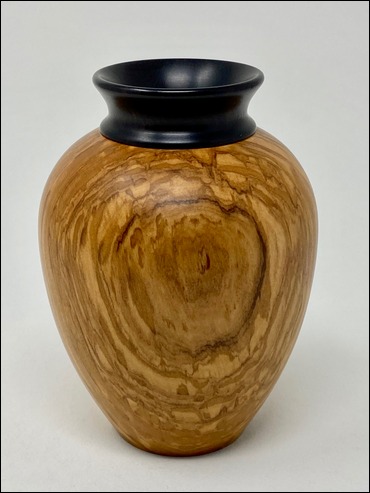 |
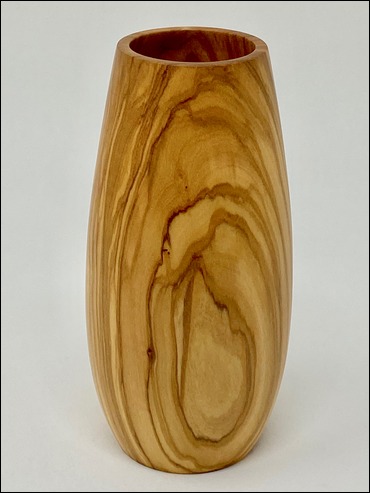 |
| Richard Branscombe says "There are many times when you put a piece of wood in the lathe and not be sure what the outcome will be, this was one of those occasions. The piece of wood was 50 mm square by 400 mm long and was turned between 4 different centres - 2 balanced and 2 - unbalanced. The 'tongue' is a thin strip of lather and the 'eyes' were an exercise in miniature turning. This was the first and probably the last time I will do this, but if anyone else wants to have a go I can send them the instructions from "Multi-Centre Woodturning" by Ray Hopper" (there are two copies of this available in the Club Library) |
|
 |
 |
| Bob Sawyer has been back in his workshop and has been 'experimenting' again. He writes: I thought I would try wood and willow, ignore the wood because I didn't want to use good stuff, I only wanted to see the visual effect and find out what problems would pop up. The height is approx. 9" tall by 6" diameter, turned as 2 bowls, one with a spigot on the base, the other as a cylinder, both marked for the holes on mating rims then drilled to 4mm dia, steel rod ( 4mm), cut 80mm long. The rods were glued into the base with Araldite epoxy. The willow was soaked for 24 hrs and then woven onto rods to within 6mm of the ends. The top was then fitted on to the rods and squeezed up to compress the willow. The piece was put back on the lathe and turned to the final shape. This piece will not be finished as it was purely an exercise in playing around... |
|
 |
|
| Martin Barrett has been working in his garden and his kitchen. Several years ago, Martin was visiting Vastern Timber in Royal Wootton Bassett and found some large sections of Cedar of Lebonon timber. Martin made this into a table top in 3-pieces, natural edges on the outsides and a parallel centre section - finished size 9' long by 3' wide by 2" thick - originally fixed using kitchen work top clamps – for easy dismantling as it was too heavy for Martin move on his own. It was used in his dining room for a few years – where it can comfortably seat 10 people. |
||
 |
 |
 |
The table has now been moved outside to the garden and the centre section removed - re-sanded and re-finished with tung oil. The top is now fitted to two old (refurbished) Singer sewing machine bases. |
|
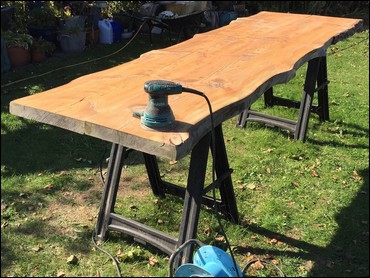 |
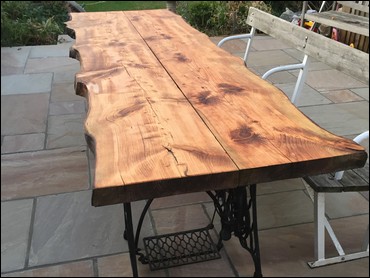 |
The table shown above has been replaced by one with a similar design. Several years after making the original table - Martin was on another visit to Vastern and found a further huge section of Cedar of Lebanon measuring approx. 9’ by 3’ by 2” thick - in one-piece. The provenance of this particular piece suggests that it was felled by the Crown Estate, Belvedere Wood, Windsor Great Park. The tree was planted by the Duke of Northumberland in circa1760. It was felled due to lightning strike – and purchased by Vastern. |
|
| New table installed in the main dining room - timber is Cedar of Lebanon - 9' long by 3' wide by 2" thick. Mounted on 4" square pine legs |
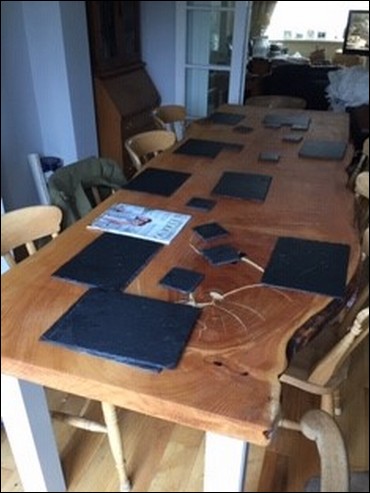 |
| Another piece of the Cedar of Lebanon - used as a bar top - installed in a friends 'Man Cave' |
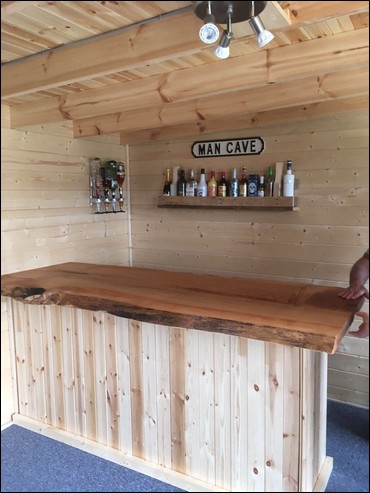 |
| Another project – almost completed – a new table from a substantial horizontal slab, cut through the trunk - approx. 4" thick by 4' across – to be fitted to a refurbished sewing machine base. |
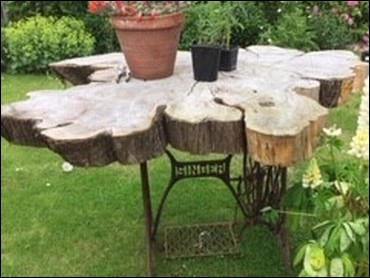 |
Butterflies a fun project - hand drawn on weathered elm and then cut out and whittled with a knife and sanded – approx. 8” by 6” by 1” thick – for decoration in the garden. A few more in left-over 20 mm thick oak flooring – approx. 6” by 4” |
|
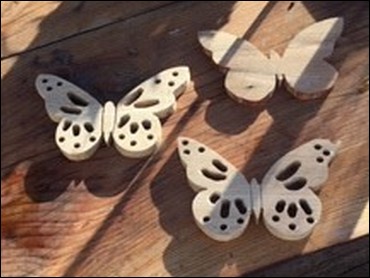 |
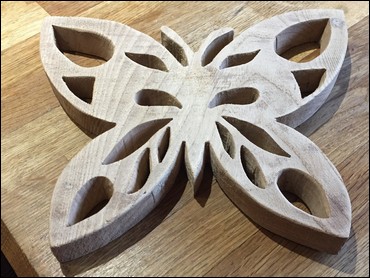 |
Martin likes to get into the kitchen where he regularly bakes bread every other day – he also likes to bake Chelsea buns. |
|
 |
 |
Ken Gateley has completed another project - this was inspired by an article in an old copy of "The Woodturner" magazine, from the April/ May 2000 edition - "A Shaker Style Rolling Pin" - very different to the usual plain wooden cylinder we would usually expect! The project consisted of: two rollers made in pear, two end plates made in oak, and a 'stretcher' with two handles made in ash (plus four brass wood screws). The rolling pin is approx. 20" long when assembled - finished in rapeseed oil. In use - the rolling pin is held by the two handles (which remain stationary in the hands) and runs back and forth on the two rotating rollers. |
|
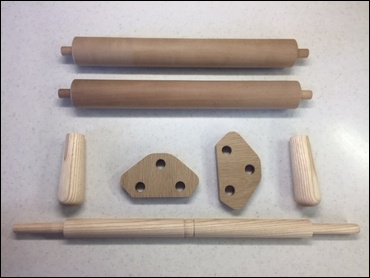 |
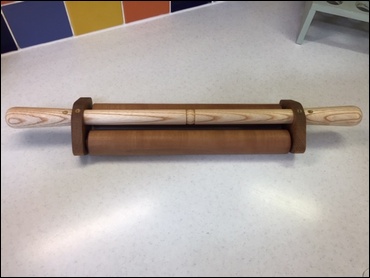 |
| <Top of Page> |
|
